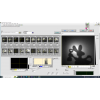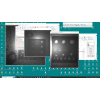LASER-DRIVEN GAMMA IMAGING STUDIES AND EXPERIMENTS FOR APPLICATIONS DEVELOPMENT
Objectives of proposed experiment:
The scientific and experimental work proposed in this program will finally
allow us to predict and optimize various laser-driven gamma beam imaging
configurations, as a starting tool for further potential development of
stand-alone microfocus gamma ray sources prototype for being used in the
development of medical, scientific and industrial high-energy gamma
microfocus imaging applications.
EXPERIMENTS FLOW DESCRIPTION
-
The GAMMA IMAGING EXPERIMENTS at ELI
NP was running for three weeks, between 27 January and 10 February, and
with two additional extension days granted, for 13 th and 14 th February. -
Most of the first two weeks time have been spent for new main optical setup, probe beam and laser beam microscope
mounting and aligning , for mechanical design of valve and target movement stages, magnet and microscope positioning
stages, for parabola beam blocker stage, target alignment and for doing first preliminary experiments with Argon gas.-
Since no accelerated electrons
-
Because the valve continued to create problems, main issue being shots without gas which created a partial damage of a
laser mirror by returned scatter laser beam, we continue the experiments only with electrons, but a poor image with
electrons was obtained in this case. -
In the last day of the given three weeks time, have been analysed the valve problem and an algorithm for controlling it
by watching the interaction chamber vacuum values was developed and the first experiments have revealed first very
promising results. -
In the last two additional days, for avoiding to make more damages, we decided to move the bremsstrahlung target to
the Aluminium exit port Flange thinned at 2mm , and to put outside the chamber the electrons deflecting magnet ,
setup being presented in Figure 1; -
In the last
day hours have been achieved the experimental gamma imaging data presented in following.
were detected with Argon gas, in the last week we have decided to change the gas with
He98%+N2% and the first results with the tantalum target came out, obtaining low quality gamma images due to the
unstable operation of the gas valve.Experiment Parameters
Laser energy on target: 1,7
2.04 J , Argon pressure: 2 bar, Gas valve predelay: 5 ms ; Valve open time: 10 ms , Laser beam valve height: 1.5 mm;
Laser beam focal size (FWHM): 24 microns, Laser pulse duration: around 30 fs;
GAMMA IMAGING EXPERIMENTS PARTICIPANTS
IFIN HH/ ELI NP Team
Ovidiu TESILEANU / CoPI
Liviu NEAGU CoPI
Yoshihide NAKAMIYA
Georgiana GIUBEGA
Florin NEGOITA
Gabriel COJOCARU
Andrei BERCEANU
Jianfuh
ONG
Petru
GHENUCHE
Madalin
ROSU
Catalin CHIOCHIU
Bogdan
TATULEA
Iani
MITU
Laser Group membersAccentPro2000 S.R.L. (AP2K)
Team
Mihai
IOVEA / PI
Marian NEAGU
Edward Hermann
Mihaela POTERASU
Monica MIREA
External collaborators
Gabriel SULIMAN ( Politehnica Univ & ELI NP)
Laura NITA (PhD student
Politehnica Univ )
GAMMA IMAGING EXPERIMENTS
CONCLUSIONS
-
Definitely the three
weeks granted beam time was totally insufficient for completing such complex experiments. -
We have learned how to look for a stable point of
gamma imaging experiment, where Laser shots are almost
continuously good shots, based on the probe beam optimum acceleration channel image, interaction chamber
vacuum variation on valve shots, EMP induced signal level and watching the Laser parameters. - The Argon gas is more suitable for the “gamma imaging applications” and low gas pressures data looks more stable.
- The gas valve malfunctions created most of the experiments issues and should be further upgraded or replaced.
-
Despite the problems encountered, the
final day hours gamma imaging experiments show promising results, an
experiment continuation being necessary; -
Main gamma imaging issues remained the
gamma beam divergence and pointing variations that reached roughly up
to 35 % of the field of view size, and a special further investigations for compensating these drawbacks are mandatory
for the future of this set up imaging capability. -
The Gamma emission during our experiments still was under optimum, being room for more experimental
improvements.
FUTURE DEVELOPMENT
-
We intend to continue our experiment by requesting a new beamtime for focusing on key mechanism of accelerating electrons by
las er gas
interactions for our specific needs: relatively low energy range useful electrons (up to 10 20 MeV) for producing useful gamma ray spectrum up to
5 6 MeV. This requirement is due to the photon energies bigger than 5 6 MeV that are depositing negligible energy in thin standa rd scintillator
(typically 0.3 1 mm) that is currently used for gamma high resolution imaging. -
We will focus on finding the experiment parameters where are obtained stable shots imaging results, where Laser successive sh
ots are almost
similar in terms on intensities, beam size and centroid positions, even if in this case we are not reaching the maximum inten sit ies of electrons or
photons . -
We will further improve the
use of the instruments for characterizing the interactions, by optimizing the probe beam visualization of the
acceleration channel, computing the plasma electrons density with Phasics device, introducing a probe set up for an electro optical crystal for
calculating the shot electrons bunch duration, improving the valve functionality and monitoring its behavior, monitoring the EMP induced signal
level, watching the Laser parameters (power, near field intensity shape, spectrum) stability and corelating their values with th e quality of gamma
imaging - An improved mechanical design of gas valve and target moving stages will reduce many of the issues encountered;
-
Developing a gamma imaging set
up and a dedicated software capable to analyze in real time each shot imaging by computing the image number
of photons, field of view dimensions, average energy of incident gamma beam, pointing positions and showing continuously thei r v ariations from
successive shots. -
We
intend to extend our applications investigation, from actual gamma imaging goals in in Since and industrial Non destructive Testing, -
to
acquiring gamma movies of objects in continuous movement/rotation by synchronizing the laser shots with the scanned object position
and -
by analyzing the
ultrashort gamma irradiation effect on bio samples, for studies regarding the effects of ultra short Gamma Ray shots in
imaging techniques, where two specialized bio scientific groups will be partnering
-
Because the valve continued to create problems, main issue being shots without gas which created a partial damage of a




















